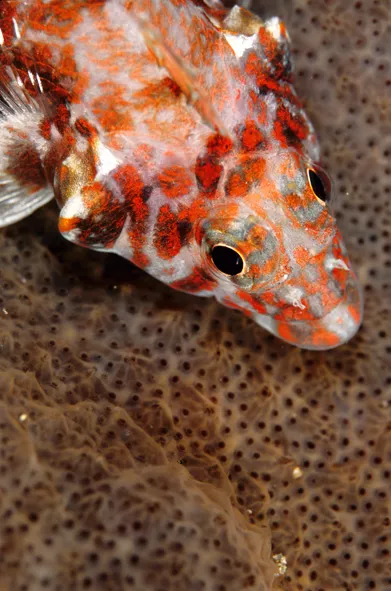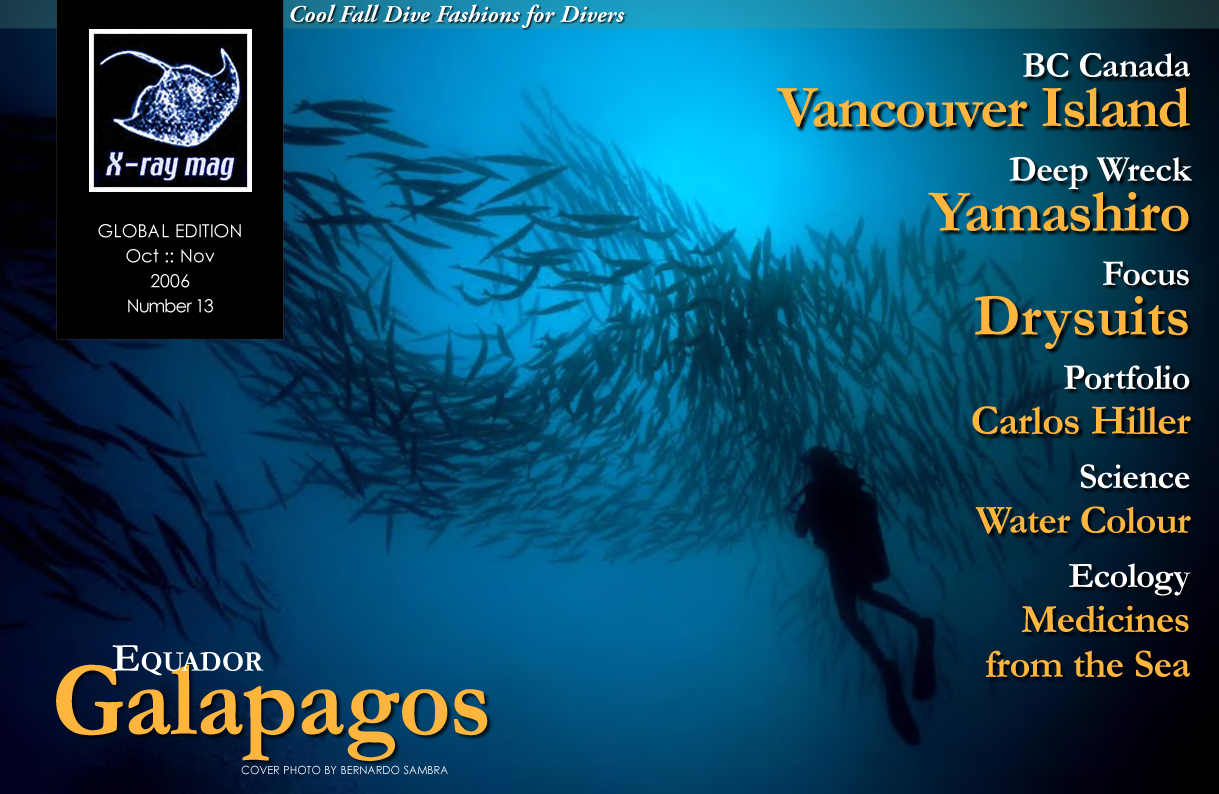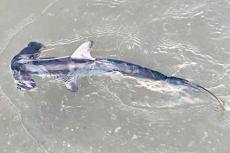“Sui Generis” is the most appropriate way I find to describe the Galapagos Islands. A place where the intruder is the human being. A place where many of its inhabitants are animals that exist only in this small piece of the world. A place where evolution seems to have been suspended at some moment in time. A place where we can feel like pioneers in each corner.
Contributed by

The Charmed Islands
The Galapagos Islands can be considered a living museum where life can be seen as it was thousands of years ago, a paradise where a person can feel like a complete intruder and inclusively to picture himself diminished before the total indifference of the animals that live in that place.
The archipelago that was baptized as the Enchanted Islands by the first Spanish navigators jumped to fame when Charles Darwin, the famous English naturalist, published the notes of what he observed after five weeks of permanence in these islands (1835) as part of his Theory of the Evolution of the Species.
The Galapagos Islands National Park is conformed by twenty islands and thirty small rocky islands distributed on a surface of 80.000 square kilometres. This group of volcanic islands is isolated in the Pacific Ocean, more than a thousand kilometres off the coast of South America.
The origin of these islands (geographic, biological and climatic) is until now a mystery. Of all these islands only four of them are occupied by people and only some of the rest can be visited by tourists whereas others maintain the access reserved exclusively for scientists.
The combination of a unique climate and the fast currents rich in nutrients that bathe the islands, sustain surroundings that are as extraordinary in the sea as in the mainland. There is no doubt that from the first moment man put his eyes on the Galapagos and until nowadays, all that has made a big impression is an oddity of the abundant animals in the virgin coasts: from the prehistoric giant turtles to small boobies that now take the name of Darwin. The isolation of the islands and time, that has allowed life to evolve and adapt to an environment in which predators never existed, ended in species that, when the first men arrived, were unusual and imperturbable.
The majority of reptiles and birds of Galapagos are endemic. Even within the archipelago, there are different species, each one limited to a single island.

A world of contrasts
Contrary to what would be thought, the climate of the Galapagos Islands is atypical for a tropical oceanic archipelago. The changing cold water presence, brought by the current of Peru (Humboldt) that arrives at the north from the southern ocean, cools and dries the Galapagos during a great part of the year. When these currents are debilitated and warmer waters from the north, typically tropical, surround the islands, begins the warm rainy season.
The experience to dive in the Galapagos is like everything that you find here, very particular, and without a doubt requires an advanced level of diving. Strong currents, drastic changes of temperature (thermoclines), cold water and often little visibility, represent a challenge for any experienced diver and mainly for the submarine photographer who will have to add a good amount of preoccupations to the already large list of things that must consider obtaining photographies in an atmosphere that can be considered hostile.
Nevertheless, the opportunity to dive in waters literally filled with life and to be part of an almost infinite procession of fish, sharks, rays, turtles, dolphins, mantas and others, justifies the greater of the efforts.

Puerto Ayora
The forced entrance to these islands is Puerto Ayora, a charming town that, with the years, has stopped being calm and quiet and became the centre of the movement of these islands. This port, located in Santa Cruz Island, is the place where starts all the tourist movement that is distributed to the different points of the archipelago.
Colourful by day, agitated by nights, Puerto Ayora stays in the memory of the traveller as the closest point to civilization in these islands. In Santa Cruz two obligatory visits have to be done. The first one, are the humid forests in the heights of the island to visit the majestic and gigantic Galápagos turtles and the second, is the creek of the Black Turtle.
This creek is a place of manglares in which, thanks to the little depth and the transparency of the waters, sharks and schools of golden head of cow mantas can be observed. A typical excursion in these manglares is on board of a zodiac moved only by oars since in this site bathing, diving or make excess noises is not allowed. It is also restricted to twelve passengers by boat.

Way to the South:
San Cristóbal, Española and Floreana
Three islands are normally visited by the divers before the long and spectacular voyage towards the remote northern islands. San Cristobal, Espanola and Floreana stand out due to their particular natural attractions and landscapes. These islands are south and south-west of the Santa Cruz Island.
In Leon Dormido I found a wall covered of barnacle shells which sheltered small, aggressive and endemic Galapagos blennies that after making me suffer for several minutes trying to focus with my camera their face in the middle of their frenzy movement allowed me to portray his magnificent colour and expression. After the dive, we made an excursion to the mainland to visit the modern Center of Interpretation.
Afterwards, we went to La Espanola, the southern island of the archipelago, very appreciated by bird’s specialists due to the great variety of species you can find on the Island. This island offers mainly two places of interest: Punta Suarez and Garner Bay. In Punta Suarez, it is possible to have the first real approach to Galapagos, by mingling with tens of blue-footed boobies and hundreds of sea iguanas that let us stay with them without a problem.
For a photographer this is like “Disneyland”... taking pictures of wild animals will never be so easy! In a place like this, you can observe behaviours as interesting as the ones of the blue-footed boobies or the spectacular Albatroz of Waved executing the hallucinating and fascinating ritual of courtship in front of our eyes.
In Garner Bay it is allowed to make immersions with snorkel surrounded by schools of surgeonfish, butterflyfish, angelfish and mainly of sea iguanas.
To arrive at Floreana we sailed just a short time but it would be possible to say that we were transported to the other end of the world. First, we walked to a lagoon, hidden after hundreds of trees and vegetation. A still lagoon filled with pink brilliant flamencos that dug the muddy ground of the lagoon in the search of food. Later, we followed a winding footpath that took us to a beach in the other side of the island where rays can frequently be observed feeding themselves in the surf of small waves. It is worth to stay in this place until dusk and enjoy sundown without precedents.
Floreana offers at least four exceptional places for diving: Corona del Diablo, Champion, Enderby and Gardner. The famous Corona del Diablo is formed by the eroded rest of a symmetrical volcanic cone. Even though coral has suffered the effect of El Nino, you can dive between eagle rays, hawkfishes, creole fishes, grunts and endemic garden eels. Moving away from the Corona, in the deep side, Jacks, Turtles and sometimes hammerheads and reef sharks can be found.
Enderby and Champion Rock offer two magnificent dives in walls covered by forests of black coral where magnificent sea horses of the Pacific can be seen.
Heading North
Finishing this trip, we went to the famous islands of the north. The voyage would take through the Bartolome Island, to the small island of Round Rock and Punta Vicente Roca in the Isabela Island. All the dives that we made during the following two days, were complemented at the end of the day with walks that allowed us to complete the panorama that is mandatory when visiting these islands. No matter how devoted to diving you are, it is indispensable to know Galapagos outside and underneath the water to be able to appreciate it in its total dimension.
Punta Vicente Roca was a particularly memorable place. We dived during night and day. Some of the divers that accompanied us had the luck to dive with two Mola Molas (Sunfish) that sometimes visit this place.
The legendary Darwin and Wolf
After the last dive near Isabela Island we started a twelve-hour trip to the legendary islands of the North: Darwin and Wolf.
A single immersion in the islands of the North end, Darwin and Wolf, located 87 miles off the north of the rest of the archipelago, can be overwhelming. Tens of Galapagos sharks, aggressive silky sharks and hammerhead sharks swimming together without showing the minimum rush or concern due to the diver’s presence. Turtles, gigantic schools of creole fish and of course magnificent and gentle whale sharks appear simultaneously, offering a spectacle difficult to find in any other part of the planet.
During three days we were anchored close to the mythical Arc of Darwin, reunion place for the whale sharks during the months of September to November. The wait for the encounter with one of these gigantic animals was long. After six divings we managed to face this magnificent animal. Regrettable, there was no current during those days and as Luis Rodriguez, our experienced guide said, with no current, not sharks.
The end of the trip was crowned with a visit to Seymour Island, to spend the afternoon with the magnificent frigate birds. Seymour is the only island where one can find these awesome birds in courtship all year round. Male frigate birds have a bright red gular sac at their throat, which they use to advertise their manhood by inflating it to astronomical size to attract the attention of potential mates.
The great majority of the people who visit Galapagos Islands feel so touched while diving in their pacific natural world that, sincerely, would want anything to grant its future. The tourist operators, whose future depends on the adequate management of this natural paradise, also support the conservation. The tourism increases day to day in these islands also the furtive fishing.
Happily, there are many people and efforts dedicated nowadays to preserve and take care of these wonderful islands. Discovering without destroying is what Galapagos need. Visit Galapagos and spread the word about its magnificence and richness but always, always remind people that this is one of the last truly wild places on earth.
About the author
Bernardo Sambra is a Peruvian underwater and wildlife photographer. His articles and photographs have appeared in a number of international publications such as Aqua, Asian Geographic, Panorama de las Américas, Golden Dolphin, Rumbos, Conde Nast Traveler, Travesías, Underwater Photography Magazine, Somos and Scuba Diver. His images and work have achieved international recognition in several international specialist competitions and his work has been presented as part of a number of underwater exhibitions as “Oceans Expo 2005”, “Master Image Makers Gallery” (2005) in Singapore and “Reflejos Submarinos” (2006). In 2005, Bernardo was a speaker and jury at Celebrate The Sea Festival in Singapore.
In the latest years, Bernardo has added to his work as a photographer, the production and edition of books related to the oceans and its inhabitants joining together the work of the world’s most talented underwater image-makers. His most recent titles are “Oceans Expo” (2005) , “Oceans” (2006) y “Oceans in Options” (2006).
Starting in 2006, Bernardo has started leading expeditions to some of the finest diving
destinations in the world.
“Protecting through images” is the slogan of The Living Oceans, an organization founded by Bernardo and his wife Valerie, that aims to raise awareness about the oceans and its inhabitants and promote the underwater photography as medium for artistic expressions in Latin America and the rest of the world.
For more information and to order Sambra’s work, please visit: www.bernardosambra.com, www.thelivingoceans.com or e-mail info@bernardosambra.com. ■























































